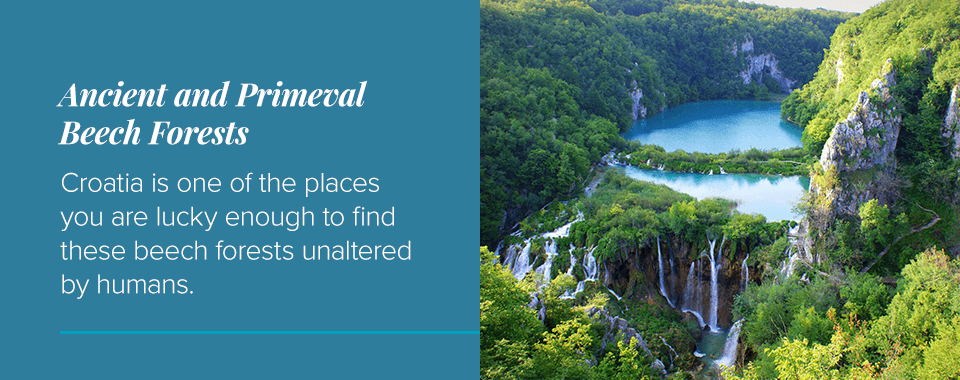
Croatia is a splendid traveling destination in the Northwestern part of the Balkan Peninsula. The coastal strip of the crescent-shaped land runs along the Adriatic Sea, with more than 1,200 islands, islets and natural formations fringing the mainland. When traveling on boutique yachts and ships, what better way to spend your time ashore than experiencing the World Heritage Sites in culturally and historically rich Croatia?
Several sites remain on the consideration list and await approval to join the Croatia UNESCO sites. Although they remain on the “Tentative List,” they are still fascinating and show how much Croatia offers. Beyond sites waiting for approval, current UNESCO World Heritage Sites in Croatia have plenty to offer.
The 10 official sites on our list comprise eight cultural and two natural sites, all longing to be explored. Before planning your magnificent adventure, see what sites await you.
In This Article
- The 10 UNESCO World Heritage Sites in Croatia
- Old City of Dubrovnik
- Historical Complex of Split
- Historic City of Trogir
- Episcopal Complex of the Euphrasian Basilica
- The Cathedral of St. James
- Venetian Works of Defence Between the 16th and 17th Centuries
- Stari Grad Plain
- Stećci Medieval Tombstone Graveyards
- Plitvice Lakes National Park
- Ancient and Primeval Beech Forests
- Plan Your Trip to Croatia’s World Heritage Sites
The 10 UNESCO World Heritage Sites in Croatia
A sailing trip to Croatia where you explore the Dalmatian coastline, visit and explore the most noteworthy UNESCO Heritage Sites, and indulge in unique cultural and culinary experiences is a once-in-a-lifetime experience. This voyage includes a fantastic array of sights to take in and experiences to be had. Whether your interests are old ruins, ancient tombstones, prominent museums, agricultural lands, diverse natural reserves or metropolitan lifestyles with flares of Mediterranean history and culture, there is sure to be something of interest for you.
Apart from the Dinaric Alps and the marvelous Dinara mountain — with an elevation of 6,003 feet — the delightful selection of the finest local wines and red-tiled roofs, there are world-famous sites to admire. Many of these can only be reached by ports, and, thankfully, small ships and boutique yachts navigate these waters and dock with ease.
When planning your next travels, be sure to consider all the marvelous places on this list and see what each has to offer.
1. Old City of Dubrovnik
Aptly named the “Pearl of the Adriatic,” this picturesque city sits on the Dalmatian coast and entrenched itself as a vital Mediterranean sea power since the 13th century. It was a prominent city-republic, thanks to its vast wealth and advanced diplomacy.
In the 16th century, the city engaged in trade with the Americas and India. Tragically around this time — 1667 — the city experienced an earthquake that damaged many beautiful Gothic, Renaissance and Baroque buildings.
Thankfully, Dubrovnik managed to repair, rebuild and preserve its sites like its churches, monasteries, palaces and cathedral. These grand structures are masterpieces that attract travelers from around the world. Following damage in the 1990s as a result of conflict, UNESCO coordinated major restoration projects to continue preserving and repairing the city.
And although a museum in itself, being recognized as a historical site in 1979, other prominent cultural draws are the numerous Dubrovnik museums. The city was also a filming location for “Game of Thrones,” specifically King’s Landing.
The extensive stone walls surrounding the city span 6,365 feet, offering a sense of pride for Dubrovnik locals. Along the border lie several towers and fortresses and various historical monuments. The wondrous architecture is a splendor, and the picturesque narrow streets offer a maze of exploring possibilities.
2. Historical Complex of Split
Of all the World Heritage Sites in Croatia, this has to be among the top attractions, partly due to the age of the sites. The ruins of Roman Emperor Diocletian’s Palace were constructed during the late third and into the early fourth centuries A.D. — you can discover these ruins throughout the city.

Parts of the original historical wall and fortifications were woven into the modern city, built around the predominant remains, to enrich the architectural and cultural heritage of Split. This ingenuity is a beautiful reminder of how our history made us and is still a part of us.
Builders used the materials from the mausoleum to construct the Cathedral of St. Domnius in the Middle Ages. Like the various churches, many other glorious structures were fashioned in the 12th-century and 13th-century Romanesque style. Gothic palaces from the 15th century stand amidst those of Renaissance and Baroque styles.
Another prominent site is the impressive Jupiter’s Temple, located in the western part of Diocletian’s Palace. It was dedicated to the Ancient Roman god Jupiter, and at the entrance is one of the Sphinxes the emperor brought from Egypt. For those who appreciate art and sculpting, the Meštrović Gallery houses many works by Ivan Meštrović, a 20th-century sculptor.
3. Historic City of Trogir
Trogir, a small island between the mainland and the island of Ciovo, lies west of Split. It is home to a high concentration of important historical sites for its size and was resultantly added to the Croatia UNESCO World Heritage Sites in 1997.
The charming harbor city predominantly relies on visitors and travelers eager to experience the history and sights for its primary source of income, so you’ll find plenty to see, do and buy. To refresh along the way, plenty of restaurants, bars and cafes sprinkle the streets.
As the glorious home to some of the best medieval architecture in Croatia, it allows you to witness places such as the 13th-century St. Lawrence Cathedral with its Romanesque front gate. It houses the Chapel of St. John of Trogir, where his coffin is kept. The bell tower is the tallest in the area and consists of three distinct styles — taking almost two centuries to complete construction.
4. Episcopal Complex of the Euphrasian Basilica
Found in the Historic Centre of Poreč, the episcopal complex has been one of Croatia’s UNESCO sites since 1997, as it is a splendid example of Byzantine architecture and dates back to the early centuries. It is believed that the episcopal complex is among the founding places of Christianity.
For those wishing to visit and witness one of the top Croatian holy sites, this is one to travel to. UNESCO justified the inscription partly due to the remarkable completeness of the religious monuments.
The episcopal complex consists of the atrium, basilica, baptistery and the episcopal palace. The most prominent features of the sights to take in are the Byzantine mosaic compilations, described by UNESCO as “the Golden Mosaics of Porec.”
Apart from the rich historic Christian ties, Poreč offers a popular summer resort. It is popular among those seeking marinas for mooring yachts and has sparkling beaches with a plethora of water sports on offer.
5. The Cathedral of St. James

Found in the town of Šibenik, this cathedral graced the list of Croatia’s UNESCO World Heritage Sites in 2000 and was a significant addition to the many architectural monuments. The Catholic church stands towering and proud in central Dalmatia. Countless visitors stand in awe of the majestic structure, which is an important monument of the transition from Gothic to Renaissance church architecture in Croatia.
The original church fell due to fire, but later in 1431, construction began on the cathedral, and the Cathedral of St. James was consecrated in 1555. Part of the illustration of Gothic and Renaissance fusion was the decorative elements throughout the cathedral.
The most curious and remarkable were the 71 sculptured faces upon the frieze — commonly called the faces on the wall. Reportedly, these were the faces of people who lived in Šibenik during the cathedral’s construction. The immense detail in these stone carvings is worth admiring, and considering the stories of these nameless people gives you an idea of a world gone by.
6. Venetian Works of Defence Between the 16th and 17th Centuries
Of all the places to visit, the Venetian works of defense are the most scattered, as they are located in Croatia and spread out into Italy and Montenegro. They are a collection of six fortified cities and forts, included in the UNESCO World Heritage Sites in 2017. The Stato da Terra protected the Lombard region of Italy, and stretching into the eastern Adriatic Coast, the Stato da Mar guarded the sea routes and ports.
The defensive works, spanning between the 16th and 17th centuries, are intriguing sites, and interesting to note is how the invention of gunpowder influenced military techniques and the designs of the structures. While in Croatia, you can visit the Fort of St. Nikola’s fortifications near Šibenik, close to where the Cathedral of St. James is located and the other is the defensive system of Zadar.
Apart from its military fortitude of the past, Zadar is now a prominent Croatian city known for offering romantic air and grand splendor. Numerous restaurants serve tantalizing Mediterranean meals, with wine shops and wineries to complement them. While exploring, you will find churches, the Cathedral of St. Anastasia and museums with a wealth of variety and vibrant squares.
7. Stari Grad Plain
Like many ancient sites, the Stari Grad Plain is still used today and is a glorious agricultural landscape. The primary cultivations are grapes and olives, just as they have been since the fourth century when there was heavy Greek influence in the region. To experience the splendor of the land, you get the chance to take a captivating Tuk Tuk tour with a splendid itinerary.
The plain near the town of Stari Grad had its roots in Greek colonists when they settled on the island of Hvar. The site is a natural reserve, and while visiting, you will spot the ancient stone structures like the walls, trims and shelters, all bearing witness to the ancient Greek system of land division.
As an agricultural landscape, gastronomy is prevalent on the island, and there are many glorious restaurants that embody the Mediterranean style and culture. Throughout the year, plenty of events and festivals incorporate a range of themes and activities, such as music, wine, cycling, live performance and culinary experiences.
8. Stećci Medieval Tombstone Graveyards
Stećci, or the singular stećak, are monumental medieval tombstones, which are often regionally distinctive and form part of ancient cemeteries. These stone monoliths were thought to be constructed in the 12th century and peaked in popularity in the 14th-16th centuries.
While traveling across Croatia, you will discover 4,400 stećci in two distinct necropolises. There are also places where the groupings are condensed. Surrounding the church of St. Barbara in Dubravka are plenty of whole and fragmented stećci, and the village of Cista Velika is home to the necropolis Velika and Mala Crljivica.
9. Plitvice Lakes National Park
Plitvice Lakes is one of Croatia’s two natural UNESCO World Heritage Sites and joined the ranks in 1979, but its boundaries were modified in 2000. The park includes breathtaking sights, such as dams, lakes, waterfalls, caves, and a spectacular ecosystem of fauna and flora, which have formed over thousands of years.
The densely forested park is home to brown bears and wolves and offers a birdwatcher’s paradise with many rare bird species. If you are a nature lover, this park promises a tranquil experience outdoors, where you can choose from various lake tour programs and explore the park on foot.
Other activities for your time at Plitvice Lakes include skiing, snowboarding and sledding during the winter months of December through March. For the equally adventurous, you can mountain climb, or for a more relaxed park experience, head out onto Lake Kozjak in a wooden rowing boat during the warmer parts of the year.
10. Ancient and Primeval Beech Forests
Like the Plitvice Lakes National Park, these forests are the second natural Croatia UNESCO site and celebrate the European beech trees that spread across the continent. The transnational property forming the Heritage Site spans 18 countries and is of the Carpathians and other regions of Europe.

The 94 beech forest areas are found in Albania, Austria, Germany, Italy and other countries. Croatia is one of the places you are lucky enough to find these beech forests unaltered by humans. According to the World Heritage Outlook, the preservation of these forests is of significant concern and shows the importance of maintaining ecological integrity.
To view the beech forests, you can make your way to the Hajdučki and Rožanski Kukovi Nature Reserve. These strictly protected reserves are part of the Velebit National Park. The Paklenica National Park offers a unique climate influence where the trees experience different habitats of alpine, continental and Mediterranean.
Plan Your Trip to Croatia’s World Heritage Sites
Croatia is a country full of cherished moments, either etched in the rich tapestry of its past or in the ones waiting for you to experience. The historic sites offer a porthole to the critical moments of the coastline of the Adriatic Sea. To begin the voyage, you’ll need an explorative spirit and a map of Croatia’s World Heritage Sites to inspire your visit.
The past is a marvelous teacher, and Windstar Cruises knows the way to Croatian world heritage. With an intimate-sized guest capacity of less than 350, enjoy an elegant voyage aboard one of our small ships as we venture to the fascinating sites of Croatia. To start planning your immersive trip to Croatia’s World Heritage Sites, contact Windstar Cruises today!






